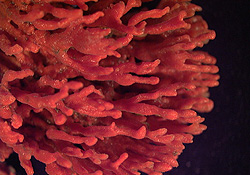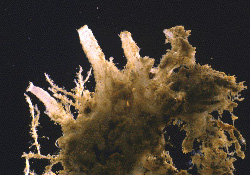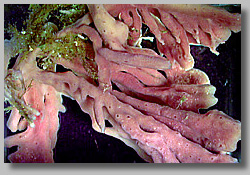ORIGINS OF THE INVERTS and SPONGE LECTURE
Early invertebrate records are scarce because of the lack of fossil evidence until about 570 million years ago (Cambium) when organisms with external skeletons appeared. All phyla that had hard outer parts existed 530 million years ago and many soft bodied animals belonging to modern phyla of worms appeared as well.
During the jellyfish-worm stage of animal evolution, the various basic designs of animal bodies evolved. First came the jellyfish, a blind sac with only two layers of cells and a single opening serving as both mouth and anus. They have radial symmetry, meaning they have no front or hind end which is adaptive to only two types of habitats...floating on the surface of the sea or attached in an immobile position on the ocean floor. Great masses of jellyfish cover wide stretches of the ocean and corals and sea anemones line tide pools in warm waters. The jellyfish phyla are dominant in these habitats and while their basic body plan adapts them admirably to certain ecological niches, it severely limits their options for colonizing others.
This body plan was also successful in flatworms but nowhere reached the dominance of the body plan of a tube within a tube design.
There are three plans, bilateral symmetry, a diversity of tissues and organs, spaces or body cavities (coelom) filled with fluid and a fourth modification is characterized by radial symmetry found in sea stars etc.
What do crabs, sea urchins, worms, corals all have in common? they have NO backbone and are all invertebrates. Over 95% of all known animals are invertebrates. Their forms range from the microscopic amoeba to giant squids 59 ft. long, inhabit all regions of the world and all have a marine representative.
SPONGES
Phylum Porifera..(pore-bearing). 5000 species of 790 genera...worldwide distribution, fresh and marine. (120 species in Keys!) Size microscopic to 2m
Sponges..animals with many pores, without definite form of symmetry, and do not contain organs or true tissues. They are all sessile. The humble bath sponge, used for centuries particularly in the Mediterranean region were originally thought of as plants but are now considered animals (only in 1765)(even its own subkingdom ..Parazoa) They probably originated from flagellated protozoans or primitive metazoans. They are the simplest of multicellular marine animals. They are so poorly organized that they are not even included in the direct line of animal evolution.
Their colors though are beautiful, Orange, yellow, green, purple, violet or scarlet or rich brown and have survived millions of years without even moving. Size range from micros. to 2m, form thin incrustation on hard surfaces to which they attach, others are massive tubular, branching, urn- or cup- or fan- shaped (amorphous).. Colors range from drab to brightly colored.
The sponges single purpose in life is to pass water through itself, the water yielding food and oxygen, minerals, and carrying away waste products. The sponges are unchanged since they evolved and were ancient 300 million years ago and appear to be natures orphans. Rachel Carson wrote that "nature seems to have gone back and made a fresh start with other materials" with no evidence of any relationship between them and coelenterates, leaving sponges in an evolutionary blind alley.
Structure.. most are similar in structure, simple body wall containing cells and connective tissues and cell types like amoebocytes which wander through the inner tissue secreting and enlarging the skeletal spicules and laying down spongin threads. Most have a skeleton of spongin, elastic, but resistant fibers of protein which may be the only means of support but can be found together with spicules. The internal skeleton can be made of hard rod or star shaped calcareous or siliceous spicules, the shapes genetically determined for each sponge, and/or the meshwork of protein fibers called spongin (bath sponge) which is similar to silk and the horns of many animals.
Sponges are filter feeders straining off bacteria and fine detritus from the water. O2 and dissolved organic matter are also absorbed and waste materials are carried away. Water is pumped inward through small pore cells into the inner chambers lined by flagellate cells called collar cells. They ingest the food particles and water is expelled through the sponges surface through the osculum.
Reproduction can occur asexually by budding off new materials, by fragmentation in which parts grow into new sponges, and in sexual reproduction, eggs from amoebocytes and sperm from collar cells (or amoebocytes) usually at different times within the individual.
Sperm is shed into the water but eggs stay in the sponge and is fertilized there. This is called spawning. A larva (amphiblastula) may be produced, swim for a few days and settle changing into colonies. Some Antarctic sponges (mature) have not grown in over 10 years.
Classification...because they adapt to their environment their shape is of no help to identify them so they are classified by their skeletons, "lime sponges, glass sponges, and fibrous or horny skeletons
Ecology. Sponges live on a firm
substratum, vertical range from intertidal to 27,000 ft (one fresh) and the
intertidal are seldom exposed to air for any time. They are eaten by sea slugs
(nudibranches) , chitins, sea stars, turtles, some tropical fish. Usually more
than half the exposed species are toxic to fish. The toxins not only prevent
predation but keep the surface of the sponge clean of animal larva and plant
spores from settling on them and may prevent neighboring invertebrates from
overgrowing and smothering them. Sponges contain antibiotic substances,
pigments, chemicals like steroids, toxins, anti-inflammatory, and
anti-arthritis compounds. Boring sponges (Cliona)
weakens oyster shells, and damage and weaken tropical stony corals excavating
chambers by chemical and mechanical methods. On reefs some weaken, while some
bind skeletons together, some protect undersurface of coral from attacks by
boring organisms and are most successful under low light. Other..sulfur sponge
is able to dissolve seashells into calcium and accounts for conversion of shells
to sand on the ocean floor.Crumb
of Bread Sponge (Hymeniacedon
perlevis)
Loggerhead sponge, shaped like barrels, host up to 12,000 pistol shrimps and other creatures. The sea orange wraps itself around a hermit crab shell, obtaining transport in exchange for the camouflage and Neptunes Cup grows out of the sea floor in the shape of a goblet.



Microciona (Red Beard Sponge) ...Leucosolinia (Organ Pipe Sponge).. Haliclona (Finger Sponge)
Demospongiae ------------------------------Calcispongiae......................................Demospongiae
1. How is water moved through the sponge?
2. What adaptations (special
structures or behavior) allow the sponge to lead a sessile existence?
3. From the outside
in, what structures comprise the body wall of the sponge?
4. Name the 4 types of
spicules and how they would be useful to biologists?
<